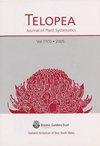亚洲一种具有重要商业价值的金合欢(豆科:金合欢科)
IF 0.6
4区 生物学
Q4 PLANT SCIENCES
引用次数: 2
摘要
描述了相思x mangiiformis Maslin和l.a.j.m onson,杂交种。它的亲本是金合欢。Benth交货。和野山麻。在亚洲和其他地方的两种著名和重要的种植树种。mangiiformis原产于巴布亚新几内亚西部省,近几十年来在东南亚(印度尼西亚、马来西亚、泰国和越南)和印度广泛种植,在中国和台湾也有少量种植。在林业文献中,这种树经常被称为“金合欢杂交”。mangiiformis具有介于其亲本之间的形态和其他特征。此外,它通常具有更快的生长速度,优越的孔洞形式和更强的耐旱性比它的亲本种。杂交种主要用于纸浆生产,但也用作实木产品和薪材。木材类似于mangium,但具有更高的密度,更适合于强度重要的产品;它也比它的亲本物种更不容易受到白蚁的攻击。越南已经培育出10个高性能的商用金合欢无性系,更多的无性系正在筛选中。这一重要杂交种的正式命名是献给Le Dinh Kha教授(原越南森林科学研究所),他是一位杰出的研究员、导师和树木育种权威,他在越南进行了许多关于mangiiformis的原始研究和推广。本文章由计算机程序翻译,如有差异,请以英文原文为准。
Acacia × mangiiformis hybrida nova (Leguminosae: Mimosoideae), a wattle of commercial importance in Asia
Acacia × mangiiformis Maslin & L.A.J.Thomson, hybrida nova, is described. Its parents are Acacia auriculiformis A.Cunn. ex Benth. and A. mangium Willd., two well-known and important plantation species in Asia and elsewhere. Acacia × mangiiformis arose naturally in the Western Province of Papua New Guinea and in recent decades has become widely cultivated in southeast Asia (Indonesia, Malaysia, Thailand and Vietnam), India, and to a lesser extent in China and Taiwan. The tree has often been referred to as “Acacia hybrid” in forestry literature. Acacia × mangiiformis has morphological and other characteristics that are intermediate between its parents. Furthermore, it often has a faster growth rate, superior bole form and is more drought-tolerant than its parent species The hybrid is used primarily for pulp production but also has uses as solid wood products and fuelwood. The wood is similar to that of A. mangium but has a higher density and is more suitable for products where strength is important; it is also less susceptible to termite attack than are its parent species. Ten high-performing commercial clones of Acacia × mangiiformis have been developed in Vietnam and more are being selected. The formal naming of this important hybrid is dedicated to Professor Le Dinh Kha (formerly of Forest Science Institute of Vietnam), an outstanding researcher, supervisor, and authority on tree breeding who conducted much of the original research and promotion of Acacia × mangiiformis in Vietnam.
求助全文
通过发布文献求助,成功后即可免费获取论文全文。
去求助
来源期刊

Telopea
PLANT SCIENCES-
CiteScore
1.30
自引率
42.90%
发文量
0
期刊介绍:
Manuscripts submitted for publication in TELOPEA are published online, after peer review and acceptance by the TELOPEA Editorial Committee and when final editorial formatting has been completed. The journal specialises in plant systematics and phylogeny. The geographic scope of the journal encompasses Australia, Malesia, Melanesia, Micronesia, and Polynesia. The suitability of a work for the journal depends on the topic and the region of origin, generally the narrower the focus of the manuscript the closer to New South Wales must be its geographic focus.
As a general guide, we will consider:
1) revisionary treatments and other substantial bodies of work from any of the regions mentioned above.
2) new species from any Australian state.
3) new country records for Australia from any state.
4) new state records from New South Wales only.
However, we aim to support botanical research across the broader Australasian and Pacific region, and will consider submissions on their merit.
Generally we will not consider extraterritorial new country records, or single lectotypification papers unless they pertain to New South Wales taxa, or have significant bearing on the Australian flora.
 求助内容:
求助内容: 应助结果提醒方式:
应助结果提醒方式:


